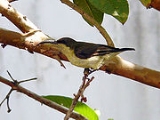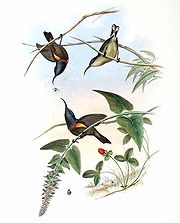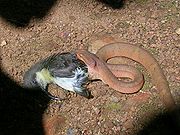
Loten's Sunbird
Encyclopedia
The Loten's Sunbird, Long-billed Sunbird or Maroon-breasted Sunbird, Cinnyris lotenius (formerly placed in the genus
Nectarinia), is a sunbird
endemic to peninsular India and Sri Lanka. Its long bill distinguishes it from the similar Purple Sunbird
that is found in the same areas and also tends to hover at flowers. Like other sunbirds, it feeds on small insects and builds characteristic hanging nests. The species is named after a colonial Dutch governor of Ceylon, Joan Gideon Loten
.
 Loten's Sunbirds are small, only 12–13 cm long. The long bill separates this from the syntopic Purple Sunbird
Loten's Sunbirds are small, only 12–13 cm long. The long bill separates this from the syntopic Purple Sunbird
. The wings are browner and the maroon breast band is visible on the male under good lighting conditions. The males have pectoral tufts of yellow mixed with crimson that are used in displays. The adult male is mainly glossy purple with a grey-brown belly. The female has yellow-grey upperparts and yellowish underparts, but lacks Purple's faint supercilium. The call is distinctive buzzy zwick zwick and they are also very active often bobbing their head while foraging. They long down-curved bills and brush-tipped tubular tongues, are adaptations to their nectar feeding. The bill lengths vary across populations with the longest bills are found on the east of Peninsular India and in Sri Lanka. The song of the male is a long repeated wue-wue-wue... with the last notes accelerated. The song has been likened to the call of the Cinereous Tit
. The males may sing from the tops of bare trees or telegraph wires.
The male in winter has an eclipse plumage with a yellowish underside resembling that of the female but having a broad central streak of dark metallic violet from the chin to the belly. The existence of an eclipse plumage in the adult male has been questioned by Rasmussen & Anderton (2005) due to the lack of specimens in evidence. Jerdon
noted however that:
 The name of the bird commemorates Joan Gideon Loten, the Dutch governor to Sri Lanka (Ceylon) who commissioned the artist Pieter Cornelis de Bevere to illustrate the natural history of the region from living and collected specimens. The plates by de Bevere included illustrations of many bird species and when Loten went back to England, he loaned these to various naturalists including George Edwards (1694–1773) who used them his Gleanings of Natural History. Carolus Linnaeus
The name of the bird commemorates Joan Gideon Loten, the Dutch governor to Sri Lanka (Ceylon) who commissioned the artist Pieter Cornelis de Bevere to illustrate the natural history of the region from living and collected specimens. The plates by de Bevere included illustrations of many bird species and when Loten went back to England, he loaned these to various naturalists including George Edwards (1694–1773) who used them his Gleanings of Natural History. Carolus Linnaeus
described this species under the genus Certhia
based on material obtained from Loten.
Gmelin
confused the species with African species and many publications of that time include inaccurate information:
, they are commoner than other sunbirds.
The breeding season is November to March in India, February to May in Sri Lanka. The nest is built by the female which may however be accompanied by the male. Two egg
s are laid in a suspended nest in a tree. The eggs are incubated only by the female for about 15 days. The nest is a bag of webs, bark and caterpillar frass. The nest is built by the female and young are fed by both parents. Nests may sometimes be reused for a second brood. It often builds its nest within the nests of "social spiders" (Eresidae).
Salim Ali notes that the species is exceptional among Indian sunbirds in not having cobwebs on the exterior.
Genus
In biology, a genus is a low-level taxonomic rank used in the biological classification of living and fossil organisms, which is an example of definition by genus and differentia...
Nectarinia), is a sunbird
Sunbird
The sunbirds and spiderhunters are a family, Nectariniidae, of very small passerine birds. There are 132 species in 15 genera. The family is distributed throughout Africa, southern Asia and just reaches northern Australia. Most sunbirds feed largely on nectar, but also take insects and spiders,...
endemic to peninsular India and Sri Lanka. Its long bill distinguishes it from the similar Purple Sunbird
Purple Sunbird
The Purple Sunbird is a small sunbird. Like other sunbirds they feed mainly on nectar, although they will also take insects, especially when feeding young. They have a fast and direct flight and can take nectar by hovering like a hummingbird but often perch at the base of flowers...
that is found in the same areas and also tends to hover at flowers. Like other sunbirds, it feeds on small insects and builds characteristic hanging nests. The species is named after a colonial Dutch governor of Ceylon, Joan Gideon Loten
Joan Gideon Loten
right|150 px|thumb|Medallion with the portrait of Joan Gideon Loten.Joan Gideon Loten was a Dutch servant in the colonies of the Dutch East India Company , Fellow of the Royal Society and Fellow of the Society of Antiquaries of London...
.
Description

Purple Sunbird
The Purple Sunbird is a small sunbird. Like other sunbirds they feed mainly on nectar, although they will also take insects, especially when feeding young. They have a fast and direct flight and can take nectar by hovering like a hummingbird but often perch at the base of flowers...
. The wings are browner and the maroon breast band is visible on the male under good lighting conditions. The males have pectoral tufts of yellow mixed with crimson that are used in displays. The adult male is mainly glossy purple with a grey-brown belly. The female has yellow-grey upperparts and yellowish underparts, but lacks Purple's faint supercilium. The call is distinctive buzzy zwick zwick and they are also very active often bobbing their head while foraging. They long down-curved bills and brush-tipped tubular tongues, are adaptations to their nectar feeding. The bill lengths vary across populations with the longest bills are found on the east of Peninsular India and in Sri Lanka. The song of the male is a long repeated wue-wue-wue... with the last notes accelerated. The song has been likened to the call of the Cinereous Tit
Cinereous Tit
The Cinereous Tit is a species of bird in the tit family Paridae. This species is made up of several populations that were earlier treated as subspecies of the Great Tit . These birds are grey backed with white undersides. The Great Tit in the new sense is distinguishable by the greenish-back and...
. The males may sing from the tops of bare trees or telegraph wires.
The male in winter has an eclipse plumage with a yellowish underside resembling that of the female but having a broad central streak of dark metallic violet from the chin to the belly. The existence of an eclipse plumage in the adult male has been questioned by Rasmussen & Anderton (2005) due to the lack of specimens in evidence. Jerdon
Thomas C. Jerdon
Thomas Caverhill Jerdon was a British physician, zoologist and botanist. He is best remembered for his pioneering works on the ornithology of India...
noted however that:
Taxonomy

Carolus Linnaeus
Carl Linnaeus , also known after his ennoblement as , was a Swedish botanist, physician, and zoologist, who laid the foundations for the modern scheme of binomial nomenclature. He is known as the father of modern taxonomy, and is also considered one of the fathers of modern ecology...
described this species under the genus Certhia
Certhia
Certhia is the genus of birds containing the typical treecreepers, which together with the Spotted Creeper make up the family Certhiidae.The typical treecreepers occur in many wooded parts of the North Temperate Zone...
based on material obtained from Loten.
Gmelin
Samuel Gottlieb Gmelin
Samuel Gottlieb Gmelin was a German physician, botanist and explorer.- Background :Gmelin was born at Tübingen in a well known family of naturalists. His father was Johann Conrad Gmelin, an apothecary and surgeon. His uncle was Johann Georg Gmelin...
confused the species with African species and many publications of that time include inaccurate information:
Distribution and habitat
Found only in peninsular India and Sri Lanka. The main region is along the Western Ghats and into the southern peninsula. There are scattered records from central India and into the northern Eastern Ghats north until Orissa. Race hindustanicus, southern Peninsular populations of which have a slightly shorter bill, is found in India while the nominate race is found in Sri Lanka. They are locally common in both forests, cultivation. They are also common in urban gardens and in some areas such as the city of MadrasChennai
Chennai , formerly known as Madras or Madarasapatinam , is the capital city of the Indian state of Tamil Nadu, located on the Coromandel Coast off the Bay of Bengal. Chennai is the fourth most populous metropolitan area and the sixth most populous city in India...
, they are commoner than other sunbirds.
Behaviour and ecology
The species is resident and no seasonal movements are known. While foraging for nectar they hover at flowers a lot unlike the Purple Sunbirds that prefers to perch beside flowers. Like other sunbirds, they also feed on small insects and spiders.The breeding season is November to March in India, February to May in Sri Lanka. The nest is built by the female which may however be accompanied by the male. Two egg
Egg (biology)
An egg is an organic vessel in which an embryo first begins to develop. In most birds, reptiles, insects, molluscs, fish, and monotremes, an egg is the zygote, resulting from fertilization of the ovum, which is expelled from the body and permitted to develop outside the body until the developing...
s are laid in a suspended nest in a tree. The eggs are incubated only by the female for about 15 days. The nest is a bag of webs, bark and caterpillar frass. The nest is built by the female and young are fed by both parents. Nests may sometimes be reused for a second brood. It often builds its nest within the nests of "social spiders" (Eresidae).
Salim Ali notes that the species is exceptional among Indian sunbirds in not having cobwebs on the exterior.

